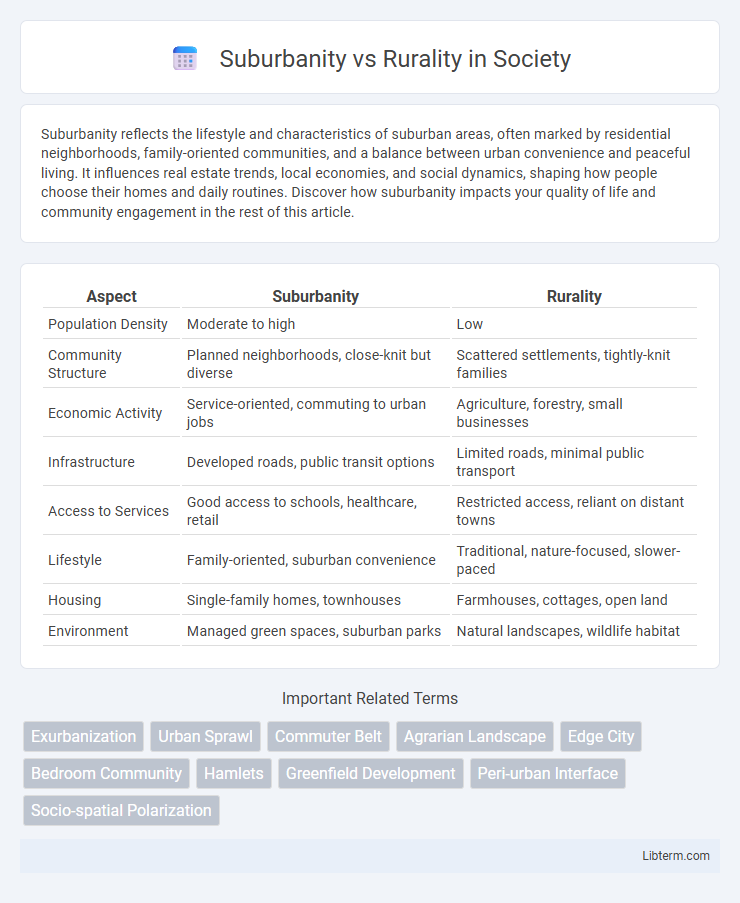Suburbanity reflects the lifestyle and characteristics of suburban areas, often marked by residential neighborhoods, family-oriented communities, and a balance between urban convenience and peaceful living. It influences real estate trends, local economies, and social dynamics, shaping how people choose their homes and daily routines. Discover how suburbanity impacts your quality of life and community engagement in the rest of this article.
Table of Comparison
| Aspect | Suburbanity | Rurality |
|---|---|---|
| Population Density | Moderate to high | Low |
| Community Structure | Planned neighborhoods, close-knit but diverse | Scattered settlements, tightly-knit families |
| Economic Activity | Service-oriented, commuting to urban jobs | Agriculture, forestry, small businesses |
| Infrastructure | Developed roads, public transit options | Limited roads, minimal public transport |
| Access to Services | Good access to schools, healthcare, retail | Restricted access, reliant on distant towns |
| Lifestyle | Family-oriented, suburban convenience | Traditional, nature-focused, slower-paced |
| Housing | Single-family homes, townhouses | Farmhouses, cottages, open land |
| Environment | Managed green spaces, suburban parks | Natural landscapes, wildlife habitat |
Defining Suburbanity and Rurality
Suburbanity is defined by its proximity to urban centers, featuring medium-density residential areas with mixed land uses, including commercial and recreational spaces, which support commuter lifestyles and localized economies. Rurality is characterized by low population density, expansive open spaces, and predominant agricultural or natural land uses, emphasizing a connection to natural resources and slower-paced living. The distinction hinges on infrastructural development, population density, and economic activities, with suburban areas acting as transitional zones between urban cores and rural landscapes.
Historical Development of Suburbs and Rural Areas
The historical development of suburbs traces back to the 19th century with industrialization prompting urban dwellers to seek residential areas outside congested cities, marked by the rise of commuter railroads and planned communities. Rural areas, by contrast, have historically relied on agriculture and resource-based economies, evolving slowly with technological advancements and shifts in land use patterns over centuries. Suburban growth has been characterized by zoning laws, automobile accessibility, and socio-economic shifts, differentiating it from the traditionally isolated and agrarian structures of rural regions.
Population Density and Demographic Differences
Suburban areas exhibit moderate to high population density characterized by mixed residential and commercial land use, supporting diverse demographic profiles often including middle-class families and working professionals. Rural regions have low population density with expansive open spaces, predominantly inhabited by older age groups engaged in agriculture or resource-based occupations. Differences in age distribution, education levels, and socioeconomic status highlight the demographic distinctions between suburbanity and rurality.
Housing Styles and Land Use Patterns
Suburbanity features predominantly single-family detached homes with uniform architectural styles, arranged in planned neighborhoods emphasizing cul-de-sacs and curvilinear street patterns to maximize privacy and green spaces. Rurality exhibits diverse housing styles including farmhouses, barns, and mobile homes scattered across expansive plots of land dedicated to agriculture, forestry, and open natural areas. Land use in suburban areas prioritizes residential zones with commercial centers and schools integrated, while rural land use is characterized by extensive agricultural fields, pastures, and minimal residential development.
Transportation and Connectivity
Suburban areas typically feature a blend of personal vehicle dependency and expanding public transit options, enhancing connectivity to urban centers through commuter rail, bus networks, and highways. Rural regions often face limited transportation infrastructure, resulting in lower public transit availability and a greater reliance on private vehicles for access to essential services and economic opportunities. Efficient suburban transportation systems contribute to reduced travel times and improved access to jobs, while rural connectivity challenges impact mobility and economic integration.
Access to Services and Amenities
Suburban areas typically offer greater access to a wide range of services and amenities, including healthcare, education, retail, and public transportation, compared to rural regions where such facilities are often limited and dispersed. Residents in suburban environments benefit from enhanced infrastructure and shorter travel times to essential services, supporting higher convenience and quality of life. In contrast, rural areas face challenges like fewer specialized medical centers, limited public transit options, and reduced availability of cultural and recreational amenities.
Cultural and Social Life Contrasts
Suburbanity often features diverse social networks with access to recreational facilities, community events, and cultural institutions, fostering a blend of urban convenience and community engagement. Rurality emphasizes close-knit relationships, traditional values, and local customs, where social life revolves around family, agricultural cycles, and communal gatherings. These cultural and social life contrasts shape residents' identities, influencing lifestyle choices, social interactions, and community participation.
Economic Activities and Employment Trends
Economic activities in suburban areas predominantly revolve around service industries, retail, and light manufacturing, driven by proximity to urban centers and diversified job markets. In contrast, rural economies depend heavily on agriculture, forestry, and resource extraction, with employment trends reflecting seasonal labor and lower population density. Suburban employment shows higher wage levels and greater occupational diversity, while rural areas often experience underemployment and limited career growth opportunities.
Environmental Impact and Sustainability
Suburbanity often leads to increased land consumption and higher greenhouse gas emissions due to reliance on vehicles and expansive infrastructure, contrasting with rurality where lower population density contributes to preserved natural habitats and reduced pollution. Rural areas typically support biodiversity and sustainable agriculture practices, though challenges such as resource access and economic development persist. Effective environmental policies must address the unique sustainability issues of both suburban expansion and rural conservation to optimize ecological balance.
Quality of Life: Pros and Cons
Suburbanity offers improved access to amenities, schools, and healthcare, promoting a higher quality of life compared to rurality, which often boasts cleaner air, lower crime rates, and a stronger sense of community. Rural areas provide tranquility and space, but limited infrastructure and fewer employment opportunities can impact overall well-being. Suburban living balances convenience and safety, though increased traffic and noise may reduce quality of life relative to rural solitude.
Suburbanity Infographic

 libterm.com
libterm.com